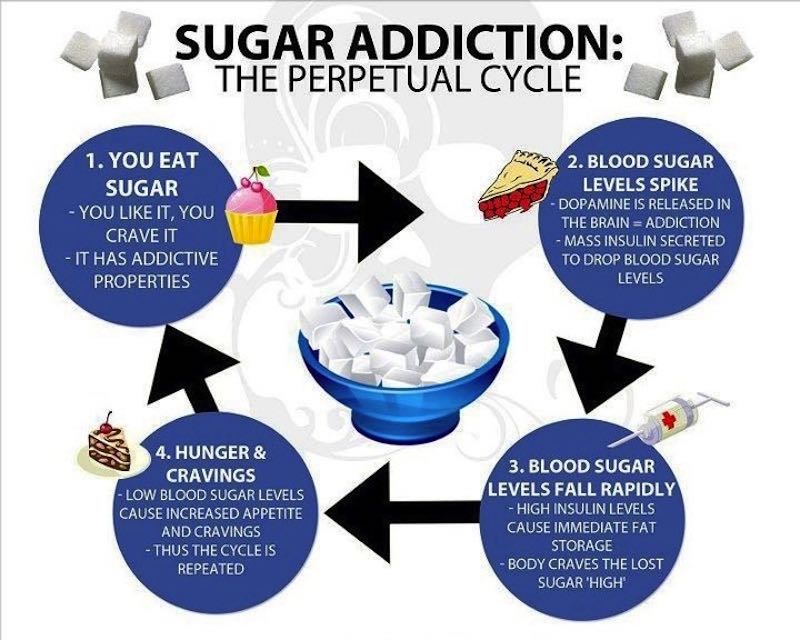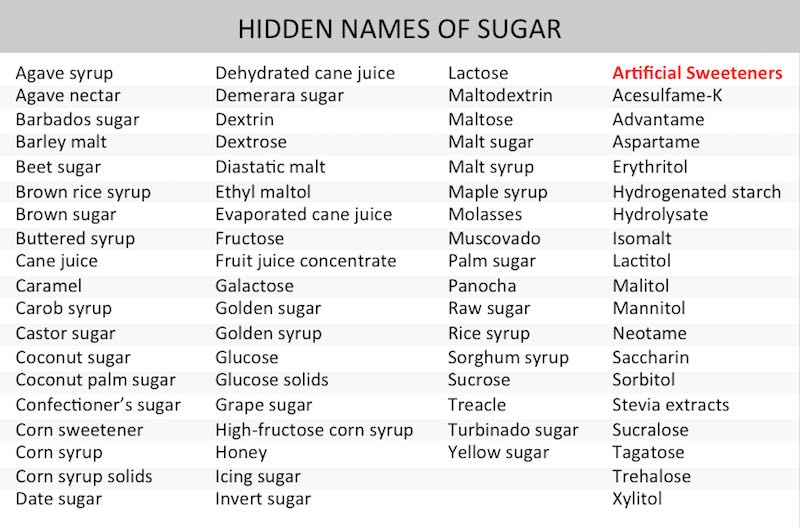Early Warning Signs That Your Blood Sugar Is High Or That You’re Pre-Diabetic
Last updated on
You add it to your morning cup of coffee or tea. You bake it into pastries, cakes, and cookies. You even sprinkle it all over your breakfast cereal or your oatmeal for added “flavor.”
But that’s not all. It’s also hidden in some beloved “treats” that people consume on a daily basis, such as sodas, fruit juices, candies, and ice cream. It also lurks in almost all processed foods, including breads, meats, and even your favorite condiments like Worcestershire sauce and ketchup.
It’s none other than sugar. Most people view sugary foods as tasty, satisfying, and irresistible treats. But I believe that there are three words that can more accurately describe sugar: toxic, addicting, and deadly.
Sugar, in my opinion, is one of the most damaging substances that you can ingest—and what’s terrifying about it is that it’s just so abundant in our everyday diet. This intense addiction to sugar is becoming rampant, not just among adults, but in children as well.
But how exactly does sugar work in our body, and what are the side effects of eating too much sugar?
Why Is Excessive Sugar Bad For Your Health?
Today, an average American consumes about 32 teaspoons of sugar per day. New numbers came out in February 2015. The Washington Post did a story on it using grams (4 grams = 1 tsp). They quoted Euromonitor’s study, which said Americans are now consuming 126 grams, which would equal close to 32 teaspoons.
Euromonitor’s study costs $1200 to access; the Washington Post interprets the study for free here. It’s definitely alarming, considering the average Englishman during the 1700s only consumed four pounds of sugar per year1 – and that’s most likely from healthful natural sources like fruits, and not from the processed foods you see in supermarket shelves today.
What’s even more disturbing is that people are consuming excessive sugar in the form of fructose or high-fructose corn syrup (HFCS). This highly processed form of sugar is cheaper yet 20 percent sweeter than regular table sugar, which is why many food and beverage manufacturers decided to use it for their products, as it would allow them to save money in the long run.
HFCS is found in almost all types of processed foods and drinks today. Just take a look at this infographic to see just how much fructose is hiding in some of the most common foods you eat.
Discover the fructose content of common foods, beverages, sauces, and even sugar substitutes in our infographic “Fructose Overload.” Visit our infographic page for the high-res version.
The bad news is that the human body is not made to consume excessive amounts of sugar, especially in the form of fructose. In fact, your body metabolizes fructose differently than sugar. It is actually a hepatotoxin and is metabolized directly into fat—factors that can cause a whole host of problems that can have far-reaching effects on your health.
Effects Of Consuming Too Much Sugar
Dr. Robert Lustig, a professor of Clinical Pediatrics in the Division of Endocrinology in the University of California and a pioneer in decoding sugar metabolism, says that your body can safely metabolize at least six teaspoons of added sugar per day.
But, since most Americans are consuming over three times that amount, majority of the excess sugar becomes metabolized into body fat—leading to all the debilitating chronic metabolic diseases many people are struggling with.
Here are some of the effects that consuming too much sugar has on your health:
- It overloads and damages your liver. The effects of too much sugar or fructose can be likened to the effects of alcohol. All the fructose you eat gets shuttled to the only organ that has the transporter for it: your liver. This severely taxes and overloads the organ, leading to potential liver damage.
- It tricks your body into gaining weight and affects your insulin and leptin signaling. Fructose fools your metabolism by turning off your body’s appetite-control system. It fails to stimulate insulin, which in turn fails to suppress ghrelin, or “the hunger hormone,” which then fails to stimulate leptin or “the satiety hormone.” This causes you to eat more and develop insulin resistance.
- It causes metabolic dysfunction. Eating too much sugar causes a barrage of symptoms known as classic metabolic syndrome. These include weight gain, abdominal obesity, decreased HDL and increased LDL, elevated blood sugar, elevated triglycerides, and high blood pressure.
- It increases your uric acid levels. High uric acid levels are a risk factor for heart and kidney disease. In fact, the connection between fructose, metabolic syndrome, and your uric acid is now so clear that your uric acid level can now be used as a marker for fructose toxicity.
According to the latest research, the safest range of uric acid is between 3 to 5.5 milligrams per deciliter. If your uric acid level is higher than this, then it’s clear that you are at risk to the negative health impacts of fructose.
Early Warning Signs Of High Blood Sugar Levels
Many of these early warning signs are often overlooked as symptoms of feeling ‘a little under the weather’ and that they will pass naturally. The reality is that your body is warning you that there is a chemical imbalance that needs rectifying. So be alert and look out for these symptoms:
- Frequent urination and waking up frequently during the night to go to the washroom
- Poor vision and hearing
- Brain fog, difficulty concentrating
- Excess abdominal fat/weight gain
- Nerve problems
- Dry mouth and constantly feeling thirsty
- Impotent
- Recurrent infections
- Slow healing of cuts and wounds
- Digestive issues
- Constant fatigue or extreme tiredness
- Feeling hungry all the time
- Dry and itchy skin
- Dark skin patches especially on the neck
Sugar Increases Your Risk of Diseases
One of the most severe effects of eating too much sugar is its potential to wreak havoc on your liver, leading to a condition known as non-alcoholic fatty liver disease (NAFLD).
Yes, the same disease that you can get from excessive alcohol intake can also be caused by excessive sugar (fructose) intake. Dr. Lustig explained the three similarities between alcohol and fructose:2
Your liver metabolizes alcohol the same way as sugar, as both serve as substrates for converting dietary carbohydrate into fat. This promotes insulin resistance, fatty liver, and dyslipidemia (abnormal fat levels in your blood).
Fructose undergoes the Maillard reaction with proteins. This causes superoxide free radicals to form, resulting in inflammation – a condition that can be also caused by acetaldehyde, a metabolite of ethanol.
Fructose can directly and indirectly stimulate the brain’s “hedonic pathway”, creating habituation and dependence, the same way that ethanol does.
But if you think that’s the only way eating too much sugar wreaks havoc on your body, you’re dead wrong. Research from some of America’s most respected institutions now confirms that sugar is a primary dietary factor that drives obesity and chronic disease development.
One study found that fructose is readily used by cancer cells to increase their proliferation – it “feeds” the cancer cells, promoting cell division and speeding their growth, which allow the cancer to spread faster.3
Alzheimer’s disease is another deadly illness that can arise from too much sugar consumption.
A growing body of research found a powerful connection between a high-fructose diet and your risk of developing Alzheimer’s disease, through the same pathway that causes type 2 diabetes. According to some experts, Alzheimer’s and other brain disorders may be caused by the constant burning of glucose for fuel by your brain.
Other diseases that are linked to metabolic syndrome and may potentially arise because of too much sugar consumption include:
- Type 2 diabetes
- Hypertension
- Lipid problems
- Heart disease
- Polycystic ovarian syndrome
- Dementia
Manage/Limit Your Sugar Consumption
Sugar, in its natural form, is not inherently bad, as long as it’s consumed in moderation. This means avoiding all sources of fructose, particularly processed foods and beverages like soda.
According to SugarScience.org, 74 percent of processed foods contain added sugar stealthily hidden under more than 60 different names.4 Ideally, you should spend 90 percent of your food budget on whole foods, and only 10 percent or less on processed foods.
I also advise you to severely limit your consumption of refined carbohydrates (waffles, cereals, bagels, etc.) and grains, as they actually break down to sugar in your body, which increases your insulin levels and causes insulin resistance.
As a general recommendation, I advise you to keep your total fructose consumption below 25 grams per day, including that from whole fruit. Keep in mind that although fruits are rich in nutrients and antioxidants, they also naturally contain fructose, and if consumed in high amounts may actually worsen your insulin sensitivity and raise your uric acid levels.
Check out this article to see how much fructose is in the common fruits you eat.
Remember that artificial sweeteners like aspartame and sucralose are also a no-no, as they actually come with a whole new set of health problems that are much worse than what sugar or corn syrup can bring. Here are some additional dietary tips to remember:
Increase your consumption of healthy fats, such as omega-3, saturated, and monounsaturated fats. Your body needs health-promoting fats from animal and vegetable sources for optimal functioning. In fact, emerging evidence suggests that healthy fats should make up at least 70 percent of your diet. Some of the best sources include organic butter from raw milk, (unheated) virgin olive oil, coconut oil, raw nuts like pecans and macadamia, free-range eggs, avocado, and wild Alaskan salmon.
Drink pure, clean water. Simply swapping out all the sweetened beverages like sodas and fruit juices for pure water can go a long way toward improving your health. The best way to gauge your water needs is to observe the color of your urine (it should be light pale yellow) and the frequency of your bathroom visits (ideally, this is around seven to eight times per day).
Add fermented foods to your meals. The beneficial bacteria in these healthful foods can support your digestion and provide detoxification support, which helps lessen the fructose burden on your liver. Some of the best choices include kimchi, natto, organic yogurt and kefir made from grass-fed milk, and fermented vegetables.
How to Shake Off Your Sugar Cravings
The temptation to eat or indulge in sugary foods will always be there, especially with the abundance of processed foods and fast foods everywhere. However, most sugar cravings arise because of an emotional challenge. If this is what causes you to crave sugar, the best solution I could recommend is the Emotional Freedom Technique (EFT). This psychological acupuncture technique is a simple and effective strategy to help control your emotional food cravings.
The video below, which features EFT practitioner Julie Schiffman, demonstrates how to use EFT to fight food cravings.
If you feel that your emotions and/or your own self-image is what’s pushing you to keep consuming sugar-loaded foods and other unhealthy treats, I recommend you try this useful technique. Prayer, meditation, exercise, and yoga are also effective tools you can try to ward off your sugar cravings.
This article was originally published on Mercola.com. It is republished here with permission.
Some of the links I post on this site are affiliate links. If you go through them to make a purchase, I will earn a small commission (at no additional cost to you). However, note that I’m recommending these products because of their quality and that I have good experience using them, not because of the commission to be made.






































 JOIN OVER
JOIN OVER
Comments